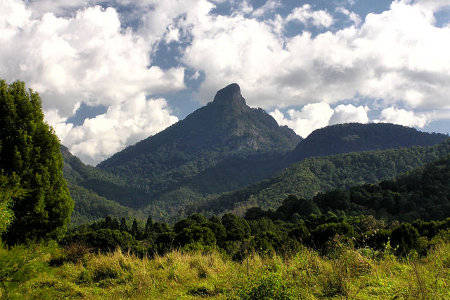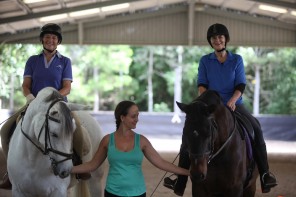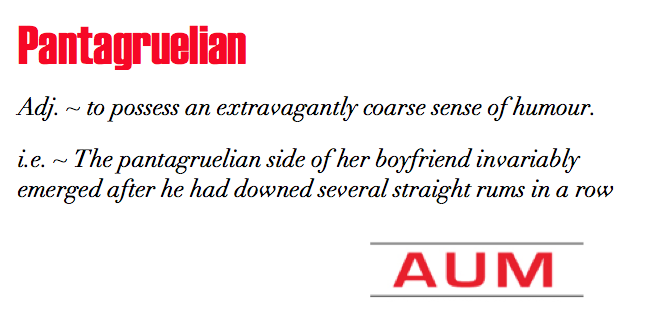You have been Warned
Mount Warning.
It looms, as it name suggests, a silent and somewhat ominous sentinel, its crooked summit a familiar sight in the landscape of the Tweed and Byron Shires in the Northern Rivers Area of New South Wales, acting as it does as an instant weather alert to local residents – if you can’t see the summit because of cloud, weather is definitely on the way.
Captain Cook, who gave the mountain its name to warn future sailors of the offshore reefs he had encountered, wasn’t to know that his version of its name closely resembles the meaning of its Aboriginal name, Wollumbin – Fighting Chief of the Mountains. The Bundjalung people believed that the lightning and thunder that clash so magnificently around the mountain were warring warriors and that the frequent landslides were wounds obtained in battle.
Of all the attractions in the Northern Rivers there are two obvious standouts – the Byron Bay Lighthouse and its accompanying walk at Cape Byron, and Mount Warning, which, due to its proximity to Cape Byron, Australia’s most Eastern point, is the first place on the mainland to receive the sun’s rays and its accompanying walk – or more precisely, climb.
For anyone interested in the idea of climbing Mount Warning let’s just say that the walk at the Lighthouse is nothing in comparison, a mere stroll in the park. A World Heritage Listed National Park of 2210 hectares, at 1,156 metres Mount Warning is not the tallest mountain in Australia – that privilege is reserved of course for Mt. Kosciuszko, but it is an arduous climb – 4-5 hours return, with the last 300 metres on chains. It is not for the faint-hearted or unfit. (And I shall try and forgive my daughter for her comment: “Well, why are you doing it then Mum?”) Water, sun-screen, nourishment and good shoes are an absolute essential for this walk.
The climb lets people know straight away that it’s not easy, with the first kilometre being a rugged set of steps, but, say experienced walkers, concentrate on one step at a time, and pretty soon you hit a stride.
Straight away, too, the rainforest begins to reveal its secrets – and it is a magical world in there – huge eucalypts, massive strangler figs and rainforest trees, right down to tiny orchids, flowering ground-cover and a plethora of bird-life. You don’t have to be a ‘twitcher’ to know that you are in the presence of something special, when a lyre-bird reveals itself in the first fifteen minutes, the amazingly-coloured Wompoo pigeon makes its strangely mournful cry, tantalisingly flying from tree to tree branch just as it’s in the camera sights, and a five minute sit-down reveals a pair of Australian robins scratching in the undergrowth.
One of the fascinating aspects of the climb, is the gradual change in landscape and in the surrounding flora. It’s not difficult to spot the different types of walkers – first there’s the competitive walkers, they’re striving to get to the top as quickly as possible (and for your information anything around one to 1.5 hours is fast); and they’re really not interested in anything going on around them – in fact they often even carry stop-watches, or shout out as they pass asking what the time is! Then there’s the largest group – the tourists in all their mixed glory – everything from hungover teenagers wearing nothing but headaches, shorts, t-shirts and thongs – no surprise they often don’t make it all the way, to groups of overseas tourists, to small groups of serious-minded middle-aged walkers, families (although this walk is not recommended for a child under ten or eleven). Then there’s what could best be described as the ‘visual’ group – those that are really ‘seeing’ the walk.
It maybe that this last group are more in the having-to-go-slow category than not, (and yes, this is the one I belong to) but to most experienced walkers of this climb, this is where the true enjoyment lies. It’s the hidden secrets of the rainforest floor and canopy, the breath-taking views, the reality of three emergency helicopter pads and the achingly slow last 500 metres that gives people the wonderful sense of achievement – that and the 360o views that open up in just a second of reaching the summit – all the way to the Gold Coast and beyond to the north, to Byron to the south, and west to the tantalizingly close Nightcap ranges.
The tradition is to climb in the dark, and be there when the first rays of sun hit the summit, but although this is a wonderful experience it is not obligatory. If the weather is cool enough for doing the climb during the day, then going up and down with the light is in itself an added bonus, although the walk should not be started after 1.00pm in winter in order to allow for the round trip with plenty of time to get back before dark.
If you’ve coped well with the climb up, don’t be lulled into a feeling of complacency – the climb back down has its own hazards. The last kilometre down, anyone will tell you, plays havoc with the knees and it’s at this point that a stout stick is a great help. Adding some pain-relieving gel to a small emergency supplies pack that should include sunscreen, mosquito repellent, water and snacks is a good idea, as is a long soak in the bath afterwards with Epsom salts to help reduce the stiffness.
For many people the climb is an annual pilgrimage, for others it’s an extreme way of getting fit, for most, it’s a once-in-a-lifetime experience. Most people choose to walk with at least one friend, and even if you have different walking paces it’s nice to know that you have company on the mountain.
The power of the Mountain is subtle – after you’ve climbed it the memory of the climb stays with you long after the stiffness has disappeared. It’s an extraordinary feeling to see its misshapen, knobbly top in the distance, looming above every other hill-top in the area, and to know that you’ve climbed it – it’s an experience I can highly recommend.
And afterwards there is always the wonderful Rainforest Café to fall into for a life-sustaining meal, or Mavis’s Kitchen with its emphasis on organic local produce, or Uki, the historic and picturesque village only a few kilometres away from the base of Mount Warning.
Most walkers choose to take a pit-stop before heading home, not just in order to refuel, but also to sit for a while and to absorb not only their achievement, but the sights, sounds and sensations of the extraordinary climb they’ve just undertaken.
For more information on Mount Warning go to: www.mtwarning.com or www.nnsw.com.au/npa/mtwarning.html





